TC Watch / 熱帶氣旋 > Selected TC Review / 重要熱帶氣旋回顧 > 201415W (KALMAEGI 海鷗) [Refresh 更新]
 201415W (KALMAEGI 海鷗) - Profile 檔案 201415W (KALMAEGI 海鷗) - Profile 檔案 |
(Issued on December 11, 2014)
(於 2014 年 12 月 11 日發出)
Brief profile of KALMAEGI 海鷗小檔案:
| JTWC number 聯合颱風警報中心 (JTWC) 號碼 | 15W |
| International number 國際編號 | 1415 |
| Period of existence 生存時期 (JTWC) | 2014/09/11 02 HKT - 2014/09/17 08 HKT |
| Lifetime 壽命 (JTWC) | 6.25 days 日 |
| Maximum 1-minute wind (JTWC) JTWC 一分鐘平均最高中心風速 | 75 knots 節 (Category 1 Typhoon 一級颱風) |
| Minimum pressure (JTWC) JTWC 最低氣壓 | 967 hPa 百帕 |
| Highest TC signal by HKO (if applicable) 香港天文台發出最高熱帶氣旋警告信號 |
8 (SE) (Gale or Storm Signal 烈風或暴風信號) |
| Closest point of approach by HKO (if applicable) 香港天文台所示之最接近距離 (如適用) |
SSW 370 km (real-time warning 實時報告 / TC report 熱帶氣旋報告) |
| Time of closest approach by HKO (if applicable) 香港天文台所示之最接近時間 (如適用) |
Around 約 2014/09/16 01 HKT (real-time warning 實時報告) / 00 HKT (TC report 熱帶氣旋報告) |
| Lowest pressure recorded at HKO (if applicable) 香港天文台錄得的最低氣壓 (如適用) |
998.7 hPa 百帕 (2014/09/16 00:36 HKT) |
TC signals for Hong Kong & Track 香港曾經生效的熱帶氣旋警告和路徑圖:
Table 表:
| Signal 信號 |
Date and time 日期和時間 |
Distance from HK 與香港的距離 |
Predicted movement 預測移動方向和速度 |
Max. 10-min winds 中心最高十分鐘平均風速 |
 |
2014/09/14 (SUN) 23:35 HKT | SE 850 km | WNW at 30 km/h | 120 km/h (65 knots, CAT. 1 / T) |
 |
2014/09/15 (MON) 12:40 HKT | SSE 510 km | WNW at 30 km/h | 130 km/h (70 knots, CAT. 1 / T) |
 |
2014/09/15 (MON) 22:30 HKT | S 370 km | WNW at 30 km/h | 130 km/h (70 knots, CAT. 1 / T) |
 |
2014/09/16 (TUE) 10:40 HKT | SW 430 km | WNW at 30 km/h | 130 km/h (70 knots, CAT. 1 / T) |
 |
2014/09/16 (TUE) 20:40 HKT | W 630 km | WNW at 28 km/h | 130 km/h (70 knots, CAT. 1 / T) |
 |
2014/09/17 (WED) 02:10 HKT* | W 750 km | WNW at 28 km/h | 110 km/h (60 knots, STS) |
*The Strong Monsoon Signal was issued one minute after the cancellation of the Standby Signal.
*強烈季候風信號於一號戒備信號取消後一分鐘發出。
Figure 圖:
(Track courtesy of Lorenzo. Data from HKO. 鳴謝 Lorenzo 提供路徑圖,資料取自天文台)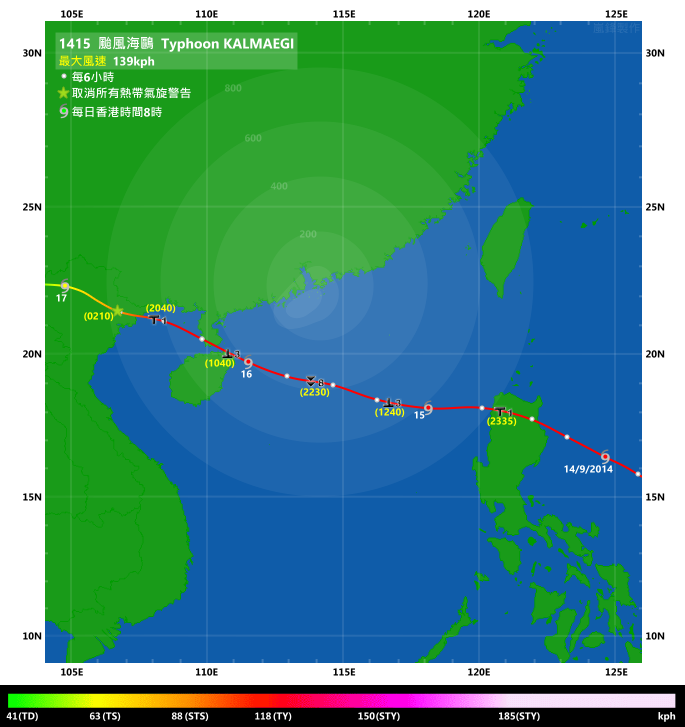
Percentile rank among storms with #8 Signal (at compilation of this review)*: *This measures the relative wind strength in Hong Kong caused by this storm compared with others that share the same signal. 指標顯示此風暴相對於其他發出同樣信號的風暴為香港帶來之風力強度 For more information, please refer to Wind Speed Data for TCs that Have Affected Hong Kong. 更多資訊載於 影響香港氣旋之風速數據 頁 |
Overall: 總計: |
|
Moderate 中等 |
|||
| Component Ranks 分部等級 | ||||||
| Reference stations: 參考站: |
|
Moderate 中等 |
||||
| Victoria Harbour: 維多利亞港: |
|
Moderately strong 中等偏強 |
||||
| Urban: 市區: |
|
Moderately strong 中等偏強 |
||||
| Offshore & high ground 離岸和高地: |
|
Moderate 中等 |
||||
Cyclones that attained similar rating (with signal #8): NESAT (2011) 相近級別之熱帶氣旋 (八號信號):納沙 (2011) |
||||||
IR imagery animation 紅外線雲圖動畫:
TC track from HKWW 本站的熱帶氣旋路徑圖:
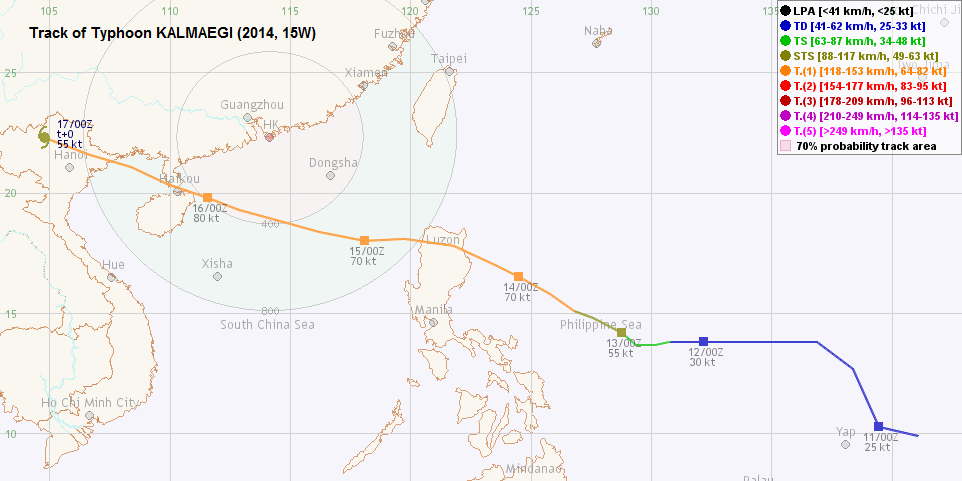
TC track from HKO 天文台的熱帶氣旋路徑圖:
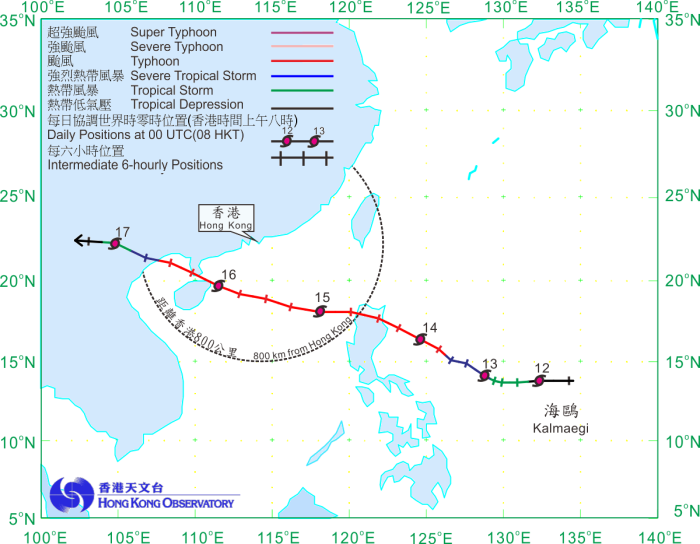
 Past HKWW Bulletins on KALMAEGI 本站有關海鷗的發佈 Past HKWW Bulletins on KALMAEGI 本站有關海鷗的發佈 |
Please click here for bulletins on KALMAEGI. 請按這裡。
 Storm Formation and Development 氣旋形成和發展 Storm Formation and Development 氣旋形成和發展 |
Unless otherwise stated, all times below are in Hong Kong Standard Time (UTC+8)
除非特別註明,下文時間均為香港標準時間 (協調世界時加 8 小時)
KALMAEGI is the only tropical cyclone this year to necessitate the #8 Gale or Storm Signal.
Tropical depression 15W developed near Yap on September 11. Convections were sparse at first and its centre was difficult to locate. This led to a relocation the next day to a much northerly position. The system stabilized and picked up a strengthening trend. It was upgraded to tropical storm status by the JMA at 2 pm September 12, and was named KALMAEGI. This name was contributed by North Korea, meaning seagull.
The steering environment at that time was typical of September. A subtropical ridge was dominating the Pacific Ocean north of KALMAEGI, and was generally WNW-ESE oriented. Under its influence, KALMAEGI was expected to move WNW throughout, crossing Luzon two to three days later and entering South China Sea. Due to the stability of the ridge, forecast from different agencies were quite consistent. Meanwhile, a tropical disturbance was inflicting unstable weather in central South China Sea. It later moved towards western Guangdong without intensifying, and did not affect KALMAEGI's track.
Seeing this potential threat, the HKO mentioned in the hourly weather readings (and also in the special weather alert) that KALMAEGI would intensify and enter South China Sea the following week, and the weather in southern China would deteriorate. As KALMAEGI's structure improved, the HKO upgraded KALMAEGI into a severe tropical storm at 10 am September 13. By that time tight convections were wrapping KALMAEGI's southern semicircle, but clouds were sparse in its northern periphery. The subtropical ridge extended southward to the east of KALMAEGI; this provided more poleward component to its track. The storm also accelerated in the second half of that day.
Both JMA and JTWC upgraded KALMAEGI into a typhoon at 8 pm September 13, while the HKO made the upgrade at 6 am the next day. KALMAEGI was forming a central dense overcast but was lacking a well-defined eye. It was moving WNW in excess of 25 km/h, and made landfall at northern Luzon at around 5 pm September 14. It spent only a few hours inland; before it emerged into South China Sea, the HKO issued the #1 Standby Signal at 11:35 pm when KALMAEGI was around 850 km from the territory. This is the first time a Standby Signal is issued outside the 800-km range since Typhoon GORDON in 1989 (830 km), and is 30 km short of the post-war record of 880 km made by Typhoon LYNN in 1987.
海鷗是本年唯一一個熱帶氣旋令香港天文台發出八號烈風或暴風信號。
熱帶低氣壓 15W 於 9 月 11 日在雅蒲島附近發展,初時其對流稀疏,中心位置較難確定,因此翌日出現一次重新定位至較北位置。此後,15W 的對流穩定下來,風暴逐漸增強。日本氣象廳於 12 日下午 2 時將其升格為熱帶風暴,並被命名為海鷗;此名由北韓提供。
當時高空流場為 9 月典型的配置,副熱帶高壓脊支配海鷗以北的太平洋,大致呈西北偏西-東南偏東向。受副高影響,預料海鷗將一直向西北偏西移動,於兩三日後橫過呂宋並進入南海。由於副高強度較為穩定,各氣象台的預測比較一致。與此同時,一低壓區為南海中部帶來不穩定的天氣,該低壓區隨後移至廣東西部,它並未增強,亦未有影響海鷗的路徑。
由於海鷗對香港存在威脅,香港天文台發出特別天氣提示,亦於每小時溫度濕度報告中提及,表示海鷗將增強並於下周進入南海,華南沿岸天氣將會轉壞。隨著海鷗的結構改善,天文台於 13 日上午 10 時將其升格為強烈熱帶風暴,當時海鷗南部被對流緊密圍繞著,而北部對流則相對空虛。由於副高於海鷗以東南伸,海鷗路徑的偏北分量增加,風暴亦於當天下半部加速。
日本氣象廳及聯合颱風警報中心均於 13 日晚上 8 時將海鷗升格為颱風,而香港天文台則於翌日早上 6 時跟隨。當時海鷗正發展出中心密集雲區,但風眼欠奉,並以超過每小時 25 公里的速度向西北偏西推進。它於 14 日下午 5 時左右登陸呂宋北部;由於其移速高,它數小時後便進入南海。而在此之前,天文台於當晚 11 時 35 分發出一號戒備信號,當時海鷗位於本港 850 公里外。這是自 1989 年颱風戈登來襲以來首次於風暴進入 800 公里範圍前就已發出戒備信號 (當時為 830 公里),而比戰後的紀錄、1987 年颱風林茵的 880 公里則要少 30 公里。
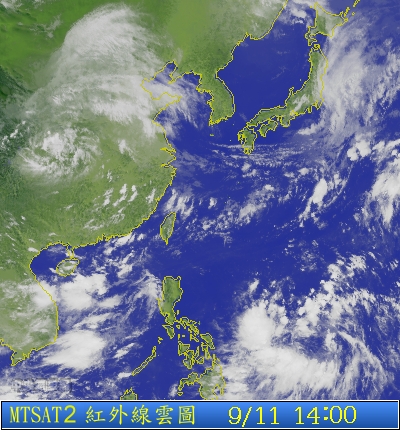
Figure 1 - Satellite image of KALMAEGI at formation, with a poorly defined centre
圖 1 - 海鷗形成時的衛星雲圖,其中心位置難以判斷
Figures 2a and 2b- Forecast tracks from different official agencies on September 12 and 15.
圖 2a 及 2b - 9 月 12 及 15 日各官方氣象台之預測路徑圖
Figure 3 - Steering chart at 8 am September 14
圖 3 - 9 月 14 日上午 8 時之駛流圖
 Crossing South China Sea 橫過南海 Crossing South China Sea 橫過南海 |
KALMAEGI entered South China Sea at around 2 am September 15. The storm dipped south slightly as it reorganized its convections perturbed by the Luzon terrain. The JTWC downgraded KALMAEGI into a tropical storm (severe tropical storm in our scale) briefly at 8 am (before reinstating its typhoon status 6 hours later) while other agencies kept it as a typhoon.
Locally, it was very hot with generally light moderate winds on September 14. As KALMAEGI drew near, winds strengthened from the northeast in the morning of September 15. The HKO issued the #3 Strong Wind Signal at 12:40 pm when KALMAEGI was 510 km SSE of Hong Kong, and would consider the need for higher signals later that evening. At the time of signal issuance, a few offshore/high-ground stations had recorded strong winds. The signal is deemed precautionary in view of the storm's unusually wide wind radius and its speed, which was forecast at 30 km/h. As KALMAEGI approached, handling of empty cargo was suspended at noon.
KALMAEGI resumed its WNW movement after consolidation, but the poleward track component was more gentle than before landfall at Luzon. Its outer rainbands started to affect the territory at around 2:30 pm; gusts associated with the rainbands resulted in a surge in wind speed at many places. Conditions deteriorated in the afternoon and the handling of laden cargo was also suspended by 5:30 pm. Many stations saw another wave of wind speed increase between 5 and 6 pm when another rainband swept across the territory, bringing Cheung Chau Beach, Ngong Ping, Tate's Cairn and Waglan Island to gale force, and some others like Tai Mei Tuk, Kowloon Star Ferry Pier, Stanley and Cheung Chau to strong force. Due to adverse weather conditions, local ferries were gradually suspended at 6:45 pm.
In the bulletin at 7 pm, the HKO mentioned that the #8 Signal would be considered before midnight. The gale radius estimate at KALMAEGI's northern semicircle was also increased from 180 NM (333 km) at 2 pm to 210 NM (389 km) at 5 pm. Since KALMAEGI was already within 400 km of the territory at 7 pm, the chance of gales affecting Hong Kong was indeed very high. The HKO issued the Pre-No. 8 Special Announcement at 8:40 pm, indicating an upgrade of the tropical cyclone signal in 2 hours.
Winds turned easterly as the night progressed. The #8 Southeast Gale or Storm Signal was issued at 10:30 pm when KALMAEGI was 370 km south of Hong Kong. Sustained hurricane force winds were observed at Ngong Ping, storm force winds were blowing at Cheung Chau Beach, and a number of stations including Chek Lap Kok, Cheung Chau, Green Island, Peng Chau, Tai Mei Tuk, Tate's Cairn and Waglan Island were observing gale force winds. An intense rainband struck Hong Kong after midnight; the Thunderstorm Warning was briefly in force.
KALMAEGI maintained a distance of around 360 km from Hong Kong near midnight, and local winds veered to ESE in the small hours of September 16. Strongest winds were generally observed between midnight and 6 am. At shortly before 1 am, Lau Fau Shan was the last reference station to start registering gale force winds. Together with Cheung Chau, Chek Lap Kok and Sai Kung, gale force winds were observed in 4 reference stations during the passage of KALMAEGI. Meanwhile, at Macau, the #8 Signal was hoisted at 1:15 am; ferry service between the two cities had already been suspended at 10:30 pm September 15 when the signal was issued in Hong Kong.
The Observatory first hinted at the possibility of lowering the signal to #3 later in the morning in its 4:45 am bulletin. The timing was made more specific 3 hours later to between 10 am and noon, and the signal was eventually replaced at 10:40 am. Sustained gales were still observed at Cheung Chau, but winds had weakened to strong force or below at most other stations. The Education Bureau announced that all day schools were to remain closed for the day. Meanwhile, public services and transportation resumed in the afternoon.
During KALMAEGI's passage, the HK Government received five reports of flooding and one case of landslide; meanwhile 29 people sought medical assistance at 10 public hospitals.
海鷗於 9 月 15 日約上午 2 時進入南海。由於其結構受呂宋地形擾亂,它重整環流時略為南移。聯合颱風警報中心曾於早上 8 時將海鷗降格為熱帶風暴 (即本站強度表的強烈熱帶風暴級),但於 6 小時後重新升格為颱風;至於其他氣象台則一直維持其颱風級別。
本地方面, 14 日風勢輕微至和緩而天氣酷熱。隨著海鷗靠近,15 日早上東北風增強。天文台於下午 12 時 40 分改發三號強風信號,當時海鷗位於香港東南偏南約 510 公里,並將於當晚考慮是否有需要改發更高信號。三號信號發出之時,部分離岸及高地氣象站已曾錄得強風。由於海鷗的風圈異常廣闊而且移動快速 (約每小時 30 公里),此信號的預警性質較重。由於海鷗逼近,吉櫃交收服務於當天正午暫停。
海鷗於重整後回復其西北偏西路徑,但偏北分量比登陸呂宋前小。它的外圍雨帶於下午 2 時 30 分左右開始影響本港,與其相關的陣風令很多地方風速有所提升。天氣於下午進一步轉壞,重櫃交收亦於下午 5 時 30 分暫停。隨著另一道雨帶靠近,大部分地方的風勢於 5 至 6 時再次增強,令長洲泳灘、昂坪、大老山及橫瀾島吹烈風,而大美督、九龍天星碼頭、赤柱及長洲等則吹強風。由於海上情況漸趨惡劣,本地渡輪服務於下午 6 時 45 分後開始陸續暫停。
在其下午 7 時的發佈中,天文台表示將於午夜前考慮改發八號信號。天文台估計海鷗的烈風圈半徑亦由下午 2 時之 180 海里 (333 公里) 擴大至下午 5 時的 210 海里 (389 公里)。由於下午 7 時前海鷗已進入本港 400 公里範圍,因此本地吹烈風的機會很高。預警八號熱帶氣旋警告信號之特別報告於下午 8 時 40 分發出,表示將於兩小時後改發更高信號。
晚間本港風向普遍轉為偏東。天文台於晚上 10 時 30 分發出八號東南烈風或暴風信號,當時海鷗位於香港以南約 370 公里。昂坪當時正持續吹颶風,長洲泳灘吹暴風,而部分氣象站如赤鱲角、長洲、青洲、坪洲、大美督、大老山及橫瀾島則吹烈風。一道強烈雨帶於午夜過後來襲,雷暴警告曾短暫生效。
海鷗於午夜跟香港保持約 360 公里距離,16 日凌晨風向轉為東南偏東。大部分地區於午夜至上午 6 時間錄得最強風速,而流浮山於凌晨 1 時前錄得烈風,成為 4 個於海鷗掠過時錄得烈風的參考站最後開始達標的一個 (其餘三個為赤鱲角、長洲及西貢)。另一方面,澳門於凌晨 1 時 15 分改發八號風球,而港澳渡輪服務則早於 15 日晚上 10 時 30 分、香港改發八號信號之時暫停。
香港天文台於上午 4 時 45 分的發佈中首次預示將於早上較後時段改發三號信號,並於 3 小時後給出介乎上午 10 時至正午的確切時間。三號強風信號最終於上午 10 時 40 分發出;當時長洲仍持續吹烈風,但其他站點的風勢大多已回落至強風以下。教育局宣布所有日校將於當日停課,而公共服務及交通工具則於下午陸續恢復。
海鷗掠過期間,香港政府接獲 5 宗水浸及 1 宗山泥傾瀉報告,另有 29 人受傷,往 10 間公立醫院診治。
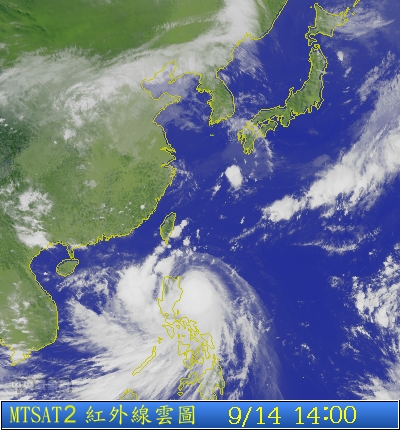

Figures 4a and 4b - Satellite images of KALMAEGI before and after crossing Luzon. It did not weaken appreciably due to its brief passge.
圖 4a 及 4b - 海鷗登陸呂宋前後的衛星雲圖。由於海鷗登陸時間短,它並未大幅減弱

Figure 5 - KALMAEGI's outer rainband affecting Hong Kong
圖 5 - 海鷗的外圍雨帶正影響本港
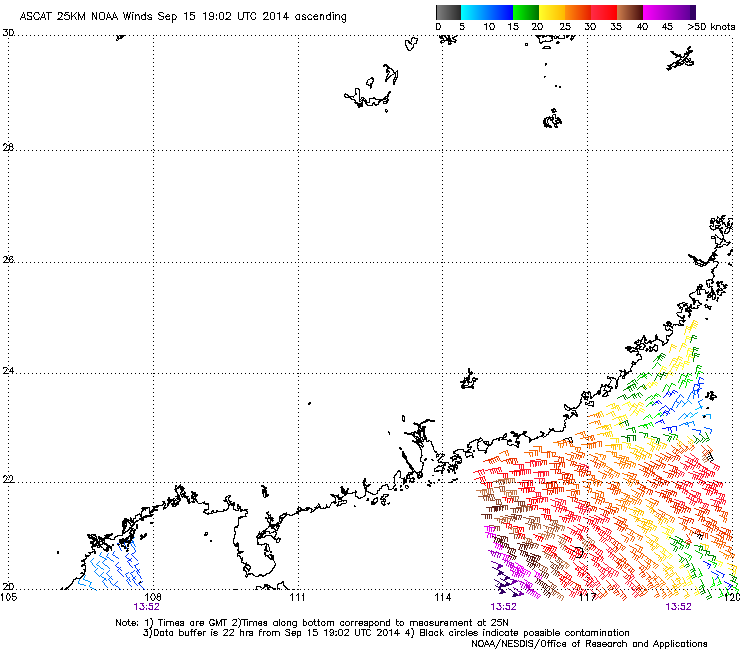
Figure 6 - Wind field in northern South China Sea at around 10 pm September 15. Gale force winds were approaching.
圖 6 - 南海北部於 9 月 15 日晚上 10 時的風場圖,顯示烈風正靠近
Figure 7 - Satellite image of KALMAEGI at closest approach to Hong Kong
圖 7 - 海鷗最接近香港時之衛星雲圖
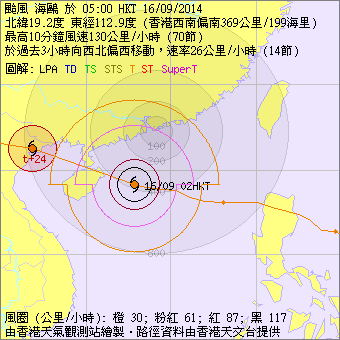
Figure 8 - HKO's estimated wind radii indicate that gales were affecting seas near Hong Kong
圖 8 - 香港天文台的估計風圈顯示烈風正影響香港一帶水域
Figures 9a to 9f - Local wind distribution maps at 4-hour intervals from 4 pm September 15 to noon the next day
圖 9a 至 9f - 9 月 15 日下午 4 時至翌日正午每四小時的本港風勢分布圖
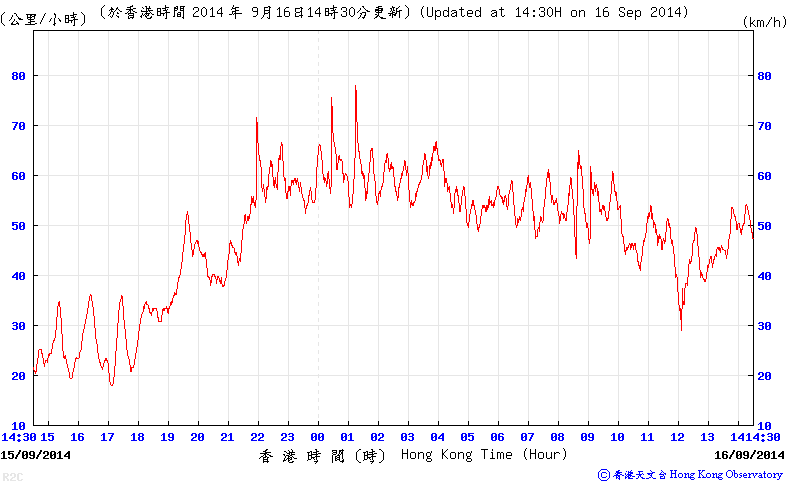

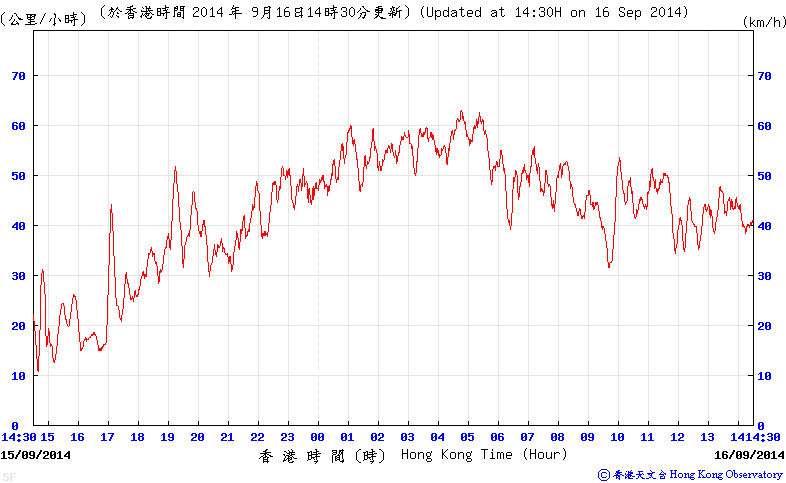
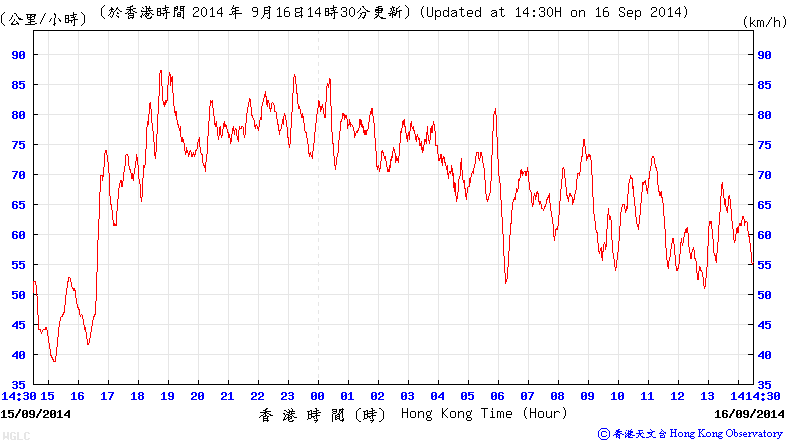
Figures 10a to 10d - Wind speed time series at Chek Lap Kok, Cheung Chau Beach, Kowloon Star Ferry Pier and Waglan Island
圖 10a 至 10d - 赤鱲角、長洲泳灘、九龍天星碼頭及橫瀾島的風速時間序列圖

Figure 11 - Sea level pressure time series at the Hong Kong Observatory
圖 11 - 香港天文台的海平面氣壓時間序列圖
 Landfall and Weakening 登陸及減弱 Landfall and Weakening 登陸及減弱 |
According to Chinese authorities, KALMAEGI made landfall near Wenchang, Hainan at 9:40 am September 16, packing winds of up to 40 m/s (144 km/h). Upon landfall, KALMAEGI's eye shrank. It later passed through Qiongzhou Strait and made landfall again at 12:45 pm near Xuwen, Guangdong. The storm subsequently entered the Gulf of Tonkin and made its final landfall at northern Vietnam at around 11 pm that night.
In Hong Kong, winds continued to diminish in the afternoon of September 16. However, gales were still observed occasionally in the southwestern parts of the territory. The Strong Wind Signal was replaced by the #1 Standby Signal at 8:40 pm when KALMAEGI was 630 km west of Hong Kong. The latter was cancelled a couple of hours later, at 2:10 am September 17, when KALMAEGI was 750 km away. The HKO also downgraded KALMAEGI into a severe tropical storm at that time. To warn the public of occasional strong southeasterly wind resulting from the combined effect of the subtropical ridge and KALMAEGI, the Strong Monsoon Signal was issued one minute after the cancellation of tropical cyclone signals. It was still rather windy in Hong Kong in the first half of September 17; the Strong Monsoon Signal remained in force until 6:15 pm that day when KALMAEGI's effect subsided completely.
KALMAEGI passed north of Hanoi in the small hours of September 17. As it became embedded inland, its supply of moisture was cut and the storm weakened rapidly. The HKO downgraded it into a tropical storm at 10 am, tropical depression at 4 pm, and further into an area of low pressure at 9 pm.
根據中國資料,海鷗於 9 月 16 日上午 9 時 40 分左右登陸海南文昌一帶,中心風力達每秒 40 米 (每小時 144 公里)。登陸後海鷗的風眼縮小,它隨後通過瓊州海峽,並於下午 12 時 45 分再度登陸廣東徐聞。風暴其後進入北部灣,於當晚 11 時左右登陸越南北部。
本港方面,風勢於 16 日下午減弱,但西南部仍間中吹烈風。天文台於下午 8 時 40 分改發一號戒備信號,當時海鷗位於香港以西約 630 公里。該信號最終於 17 日凌晨 2 時 10 分解除,海鷗當時已距離本港 750 公里,而天文台亦同時將海鷗降格為強烈熱帶風暴。熱帶氣旋警告信號解除後一分鐘,天文台即發出強烈季候風信號,以警示受副高及海鷗的共同影響下本港間中吹東南強風。17 日上半部本港風勢仍較大,強烈季候風信號直至下午 6 時 15 分才解除,海鷗對本港的風力影響至此完結。
海鷗於 17 日凌晨掠過河內以北地區。隨著海鷗繼續深入內陸,其濕氣供應被截斷,風暴快速減弱。天文台於早上 10 時將海鷗降格為熱帶風暴,下午 4 時進一步降格為熱帶低氣壓,最終於晚上 9 時將其降格為低壓區。
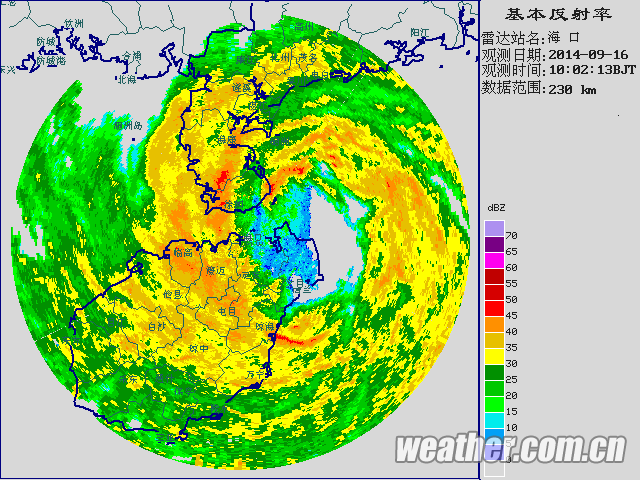
Figure 12 - KALMAEGI making landfall at northeastern Hainan
圖 12 - 海鷗於海南東北角登陸
Figure 13 - KALMAEGI weakened into an area of low pressure less than one day after landfall
圖 13 - 海鷗於登陸後不足一天減弱為低壓區
 Winds Recorded at Reference Stations 參考站所錄得的風速 Winds Recorded at Reference Stations 參考站所錄得的風速 |
| Station 風速站 |
Max. 10-min avg. wind speed 最高十分鐘平均風速 |
Beaufort classification 蒲福氏風級分類 |
| Chek Lap Kok 赤鱲角 | 78 km/h | GALE 烈風 |
| Cheung Chau 長洲 | 93 km/h | STORM 暴風 |
| Kai Tak 啟德 | 50 km/h | STRONG 強風 |
| Lau Fau Shan 流浮山 | 68 km/h | GALE 烈風 |
| Sai Kung 西貢 | 66 km/h | GALE 烈風 |
| Sha Tin 沙田 | 29 km/h | Moderate 和緩 |
| Ta Kwu Ling 打鼓嶺 | 42 km/h | STRONG 強風 |
| Tsing Yi (SHL) 青衣蜆殼油庫 | 40 km/h | Fresh 清勁 |
| Number of stations recording at least STRONG force (force 6 - 7) winds: | 6 |
| Number of stations recording at least GALE force (force 8 - 9) winds: | 4 |
| Number of stations recording at least STORM force (force 10 - 11) winds: | 1 |
| Number of stations recording HURRICANE force (force 12) winds: | 0 |
| 錄得 強風 (6 - 7 級) 或更高風速的站數: | 6 |
| 錄得 烈風 (8 - 9 級) 或更高風速的站數: | 4 |
| 錄得 暴風 (10 - 11 級) 或更高風速的站數: | 1 |
| 錄得 颶風 (12 級) 風速的站數: | 0 |
 Charts and Figures 各項數據 Charts and Figures 各項數據 |
Table 1: Track data from HKWW:
表一 : 香港天氣觀測站之路徑資料
YYMMDDZZ Lat Long Wind |
Table 2: Maximum gust and hourly average wind speed recorded in Hong Kong from HKO:
表二 : 香港天文台公佈的各站最高每小時平均風力和陣風數據
| Maximum Gust | Maximum Hourly Mean Wind | |||||||
|---|---|---|---|---|---|---|---|---|
| Station | Direction | Speed (km/h) | Date/Month | Time | Direction | Speed (km/h) | Date/Month | Time |
| Bluff Head (Stanley) | ESE |
96 |
16/9 |
08:13 |
ESE |
58 |
16/9 |
02:00 |
| Central Pier | E |
96 |
16/9 |
06:03 |
E |
56 |
15/9 |
23:00 |
| Cheung Chau | SE |
137 |
16/9 |
01:02 |
ESE |
85 |
16/9 |
08:00 |
| Cheung Chau Beach | E |
130 |
16/9 |
01:06 |
E |
96 |
16/9 |
02:00 |
| Green Island | NE |
117 |
15/9 |
23:27 |
NE |
77 |
16/9 |
00:00 |
| Hong Kong International Airport | E |
108 |
16/9 |
00:27 |
E |
62 |
16/9 |
01:00 |
E |
62 |
16/9 |
04:00 |
|||||
| Kai Tak | ESE |
87 |
16/9 |
01:10 |
E |
43 |
16/9 |
11:00 |
| King's Park | SE |
99 |
16/9 |
01:58 |
SE |
49 |
16/9 |
02:00 |
| Lau Fau Shan | ENE |
115 |
16/9 |
00:51 |
ENE |
54 |
16/9 |
01:00 |
| Ngong Ping | ENE |
175 |
16/9 |
00:15 |
ENE |
118 |
16/9 |
00:00 |
| North Point | E |
101 |
16/9 |
00:00 |
E |
49 |
15/9 |
23:00 |
E |
49 |
16/9 |
05:00 |
|||||
| Peng Chau | E |
113 |
16/9 |
00:26 |
E |
75 |
16/9 |
00:00 |
| Ping Chau | E |
59 |
16/9 |
00:34 |
E |
22 |
16/9 |
00:00 |
| Sai Kung | SE |
94 |
16/9 |
01:44 |
ENE |
59 |
16/9 |
01:00 |
| Sha Chau | SE |
92 |
16/9 |
09:40 |
SE |
65 |
16/9 |
10:00 |
| Sha Lo Wan | E |
104 |
15/9 |
23:09 |
E |
56 |
16/9 |
00:00 |
| Sha Tin | NE |
77 |
16/9 |
00:33 |
ENE |
25 |
16/9 |
01:00 |
| Shek Kong | E |
81 |
16/9 |
05:20 |
E |
38 |
16/9 |
03:00 |
| Star Ferry (Kowloon) | E |
101 |
15/9 |
19:08 |
E |
58 |
16/9 |
05:00 |
| Ta Kwu Ling | E |
87 |
16/9 |
06:56 |
E |
31 |
16/9 |
08:00 |
| Tai Mei Tuk | ENE |
135 |
16/9 |
01:11 |
E |
85 |
16/9 |
01:00 |
| Tai Mo Shan | E |
169 |
16/9 |
01:37 |
E |
110 |
16/9 |
03:00 |
| Tai Po Kau | SE |
108 |
16/9 |
01:51 |
E |
58 |
16/9 |
01:00 |
| Tap Mun | E |
90 |
16/9 |
00:50 |
E |
45 |
16/9 |
01:00 |
E |
90 |
16/9 |
00:52 |
|||||
| Tate's Cairn | ESE |
139 |
16/9 |
01:09 |
E |
88 |
16/9 |
05:00 |
| Tseung Kwan O | NE |
76 |
15/9 |
23:42 |
NE |
20 |
15/9 |
22:00 |
| Tsing Yi Shell Oil Depot | - |
81 |
16/9 |
02:04 |
- |
36 |
16/9 |
04:00 |
- |
81 |
16/9 |
04:29 |
- |
36 |
16/9 |
06:00 |
|
- |
81 |
16/9 |
04:44 |
|||||
| Tuen Mun Government Offices | ESE |
81 |
16/9 |
09:45 |
SE |
36 |
16/9 |
12:00 |
| Waglan Island | E |
112 |
16/9 |
00:15 |
E |
79 |
15/9 |
23:00 |
| Wetland Park | E |
83 |
16/9 |
01:05 |
E |
34 |
16/9 |
01:00 |
| Wong Chuk Hang | SE |
108 |
16/9 |
00:50 |
E |
41 |
16/9 |
00:00 |
Table 3: Rainfall (in millimetres) contributed by KALMAEGI from HKO (figures in brackets are based on incomplete hourly data):
表三 : 香港天文台公佈的各站雨量資料 (方括號內之數據由不完整之每小時資料擷取)
| Station | 15-Sep |
16-Sep |
Total Rainfall (mm) |
|
|---|---|---|---|---|
| Hong Kong Observatory | 17.6 |
51.6 |
69.2 |
|
| Hong Kong International Airport (HKA) | 2.4 |
35.7 |
38.1 |
|
| Cheung Chau (CCH) | 9.0 |
9.0 |
18.0 |
|
| H23 | Aberdeen | 11.5 |
43.5 |
55.0 |
| N05 | Fanling | [32.5] |
[66.0] |
[98.5] |
| N13 | High Island | 9.0 |
[29.0] |
[38.0] |
| K04 | Jordan Valley | [18.0] |
33.0 |
[51.0] |
| N06 | Kwai Chung | [12.5] |
56.0 |
[68.5] |
| H12 | Mid Levels | 15.0 |
70.0 |
85.0 |
| N09 | Sha Tin | 18.5 |
45.5 |
64.0 |
| H19 | Shau Kei Wan | 10.5 |
39.0 |
49.5 |
| SEK | Shek Kong | 26.0 |
59.5 |
85.5 |
| K06 | So Uk Estate | 15.0 |
52.5 |
67.5 |
| R31 | Tai Mei Tuk | 34.5 |
34.5 |
69.0 |
| R21 | Tap Shek Kok | 4.0 |
21.0 |
25.0 |
| N17 | Tung Chung | 4.5 |
34.0 |
38.5 |
| R27 | Yuen Long | 12.0 |
[40.0] |
[52.0] |
Last Accessed 最近訪問日期: Sun Sep 08 2024 12:37:07 HKT
Last Modified 最近修訂日期: Mon Jul 24 2023











